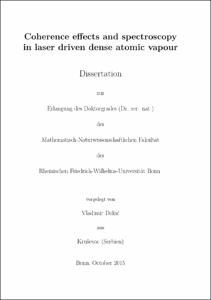Ðokić, Vladimir: Coherence effects and spectroscopy in laser driven dense atomic vapour. - Bonn, 2016. - Dissertation, Rheinische Friedrich-Wilhelms-Universität Bonn.
Online-Ausgabe in bonndoc: https://nbn-resolving.org/urn:nbn:de:hbz:5n-42755
Online-Ausgabe in bonndoc: https://nbn-resolving.org/urn:nbn:de:hbz:5n-42755
@phdthesis{handle:20.500.11811/6719,
urn: https://nbn-resolving.org/urn:nbn:de:hbz:5n-42755,
author = {{Vladimir Ðokić}},
title = {Coherence effects and spectroscopy in laser driven dense atomic vapour},
school = {Rheinische Friedrich-Wilhelms-Universität Bonn},
year = 2016,
month = feb,
note = {In this work quantum coherence effects in dense rubidium atomic vapour are investigated. Prepared in a laser driven atomic system, coherent effects, like the well-known electromagnetically induced transparency, have a remarkable ability to significantly alter optical properties of the used medium. Electromagnetically induced transparency and related phenomena like slow and stored light can be explained in terms of dark state polaritons, representing quasiparticles consisting of light and matter components. In this thesis, experiments aiming to the concept of quasiparticles are described.
Furthermore, in this thesis the concept of resonance retrieval of a stored coherence is investigated, a concept that might prove useful in metrology.
In this thesis, the focus is set on the experimental study of the particle-like nature of dark state polaritons. Therefore, a radiofrequency spectroscopy is performed on stationary and moving polaritons with an internal level structure. To this end, an experimental setup is described that allows for the existence of two state dark polaritons in a tripod level scheme. The internal level structure of these polaritons is then probed by a radiofrequency field and a transfer of population between two dark states is observed. The measured population transfer, though with a limited contrast, strongly indicates that dark state polaritons can be considered as quasiparticles with an internal level structure.
Since the dark state polaritons exhibit features of an effective magnetic dipole moment, the existence of the Aharonov-Casher phase effect for these quasiparticles is investigated experimentally. It is predicted by a known Aharonov-Casher effect that taking two particles with a finite magnetic dipole moment around a line of charge causes an accumulated phase difference between them. In this work, a detection system with a phase sensitivity of 10-5 rad is described, which sets the upper boundary on the experimentally detectable Aharonov-Casher phase for the hot rubidium gas system.
In the last part of this thesis experiments on storage and resonant retrieval of an atomic coherence are described. To this end, an RF field creates an atomic coherence which is stored and subsequently read out with an optical field. The retrieved field is shown to be frequency locked to the optical field. The difference frequency is, within the limits of experimental sensitivity, at the atomic resonance frequency independently on the amplitude and frequency variations of the radiofrequency excitation field.},
url = {https://hdl.handle.net/20.500.11811/6719}
}
urn: https://nbn-resolving.org/urn:nbn:de:hbz:5n-42755,
author = {{Vladimir Ðokić}},
title = {Coherence effects and spectroscopy in laser driven dense atomic vapour},
school = {Rheinische Friedrich-Wilhelms-Universität Bonn},
year = 2016,
month = feb,
note = {In this work quantum coherence effects in dense rubidium atomic vapour are investigated. Prepared in a laser driven atomic system, coherent effects, like the well-known electromagnetically induced transparency, have a remarkable ability to significantly alter optical properties of the used medium. Electromagnetically induced transparency and related phenomena like slow and stored light can be explained in terms of dark state polaritons, representing quasiparticles consisting of light and matter components. In this thesis, experiments aiming to the concept of quasiparticles are described.
Furthermore, in this thesis the concept of resonance retrieval of a stored coherence is investigated, a concept that might prove useful in metrology.
In this thesis, the focus is set on the experimental study of the particle-like nature of dark state polaritons. Therefore, a radiofrequency spectroscopy is performed on stationary and moving polaritons with an internal level structure. To this end, an experimental setup is described that allows for the existence of two state dark polaritons in a tripod level scheme. The internal level structure of these polaritons is then probed by a radiofrequency field and a transfer of population between two dark states is observed. The measured population transfer, though with a limited contrast, strongly indicates that dark state polaritons can be considered as quasiparticles with an internal level structure.
Since the dark state polaritons exhibit features of an effective magnetic dipole moment, the existence of the Aharonov-Casher phase effect for these quasiparticles is investigated experimentally. It is predicted by a known Aharonov-Casher effect that taking two particles with a finite magnetic dipole moment around a line of charge causes an accumulated phase difference between them. In this work, a detection system with a phase sensitivity of 10-5 rad is described, which sets the upper boundary on the experimentally detectable Aharonov-Casher phase for the hot rubidium gas system.
In the last part of this thesis experiments on storage and resonant retrieval of an atomic coherence are described. To this end, an RF field creates an atomic coherence which is stored and subsequently read out with an optical field. The retrieved field is shown to be frequency locked to the optical field. The difference frequency is, within the limits of experimental sensitivity, at the atomic resonance frequency independently on the amplitude and frequency variations of the radiofrequency excitation field.},
url = {https://hdl.handle.net/20.500.11811/6719}
}






